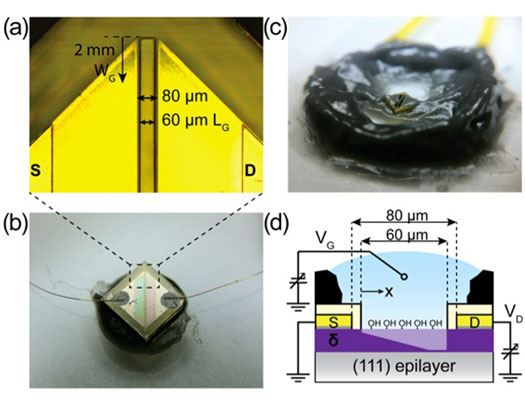| Apr 27, 2012 |
Doped diamond structures offer promise for biotech applications
|
|
(Nanowerk News) In a collaboration with Waseda University in Tokyo, London Centre for Nanotechnology (LCN) researchers have grown highly boron doped diamond layers only 1nm in thickness, a technique known as d-doping, for the realisation of high performance field effect transistors (FETs). When used in a novel configuration, where the normal metal gate that controls the transistor is replaced by an ion containing solution, such devices offer the prospect of highly sensitive detection of biochemical agents, or even action potentials from living cells (see paper in Biosensors and Bioelectronics: "Boron δ-doped (1 1 1) diamond solution gate field effect transistors").
|
 |
| (a) Micrograph of SGFET source, gate and drain showing passivation openings. (b) Macro photograph of wire bonded device prior to encapsulation. Sample is 2x2 mm. (c) Epoxy encapsulated SGFET. (d) Experimental setup of SGFET using a MESFET analogy, depicting the channel depleted in the saturation regime.
|
|
Professor Richard Jackman, who heads the LCNs Diamond Electronics Group, stated "this is the first time that the (111) crystal plane of diamond has been used to generate such heavily doped yet so incredibly thin layers. The resulting transistors offer very good gain and transconductance values when compared to similar devices".
|
|
The work was performed in a collaboration between the LCN and Professor Kawarada's Diamond Devices team in Japan, with the secondment of Robert Edgington, a PhD student with the LCN team, to Waseda University for five months being made possible through a "Japan Society for the Promotion of Science (JSPS)" award. Robert found the experience valuable beyond just science, "to spend five months immersed in Japanese culture was transforming for me" said Robert, who had the opportunity to practice the Japanese language he had been studying in London prior to his visit.
|
|
"Diamond surfaces offer a unique platform for chemical functionalisation for the purposes of biosensing" states Professor Jackman, who continued "we have encouraging initial data on the detection of PDGF, a growth factor linked with the promotion of cancer, using aptamers bound to the surface of the gate of the diamond transistor".
|
|
Robert, who will continue similar work as a Postdoctoral Research Fellow with the UCL Diamond team, added "the work was very hands-on, with the development of diamond growth and doping techniques, the design of FET device structures, and the manipulation of biochemical species, representing a truly interdisciplinary activity".
|

